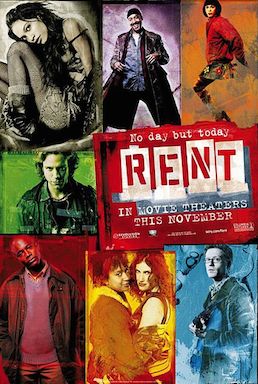 I love theatre, and I love musicals. My spouse and I used to perform in our local community theatre troupe, before toxic politics sank it. So gosh, I should really like Rent, right?
I love theatre, and I love musicals. My spouse and I used to perform in our local community theatre troupe, before toxic politics sank it. So gosh, I should really like Rent, right?
I like a lot of the songs, maybe rising as far as loving one or two of them, but when I finally got to watch the film version, my biggest memory is of being underwhelmed. I remember getting to know these characters, getting somewhat intrigued by their situations, and then a blur and the movie was over, and I didn’t really feel much of anything about what I’d just seen.
I know, watching a film of something virtually never stands up to watching it in its original medium, and particularly watching a film version that tanked and was not well-received critically is beyond unfair to the show. But I’ve never gotten an opportunity to watch it on stage, so this is all I’ve got.
But tonight I saw that the movie was on television, and I got to wondering if perhaps I had misjudged it. It’s only been a little over a decade since the film came out, so I was well into my thirties when I saw it, certainly an adult by any stretch. But I’ve experienced so much since then, it’s hard not to look back at early-thirties me and think, that person was just a kid. Maybe I would get the movie now, in a way that I didn’t back when it was new.
Well, no.
What I do have now, in my forties and a few years into a tiny little “career” as a selling author, is better tools with which to understand why something fails to work with me. I also find that analyzing why narratives fail is pretty useful, and generally less overwhelming than articulating all the reasons why successful narratives do work.
What I see now in the movie version of Rent is a dropped third act. I’m just using the term “third act” as a convenient shorthand. I don’t know that it was written in three acts, and I’m not faulting it for failing to hew to the so-popular-it’s-getting-trite three act structure. What I mean is that I am introduced to a number of characters, I learn what each character seems to need or want, I am shown some highs and lows and invited to care about them, and then, when things look their bleakest, the movie tries to tie the story back up together into some kind of a bittersweet we’ve-all-suffered-but-now-we’ve-grown climax, and it’s a mess and it utterly fails.
I wish I’d glanced at the time when the funeral scene was going on, because that’s where it all . . . well, not where it came apart, but where it failed to come together. Roger moves to Santa Fe and . . . then he comes back. Mark goes back to working on his own film . . . because . . . well, because that’s what the story needed him to do. We don’t actually see the other characters have any transformative moments, unless you want to say that looking for the missing Mimi counts, which, fair enough, but as with Roger and Mark, we don’t actually see the characters grow, we don’t see them move past the separation they demonstrated at Angel’s funeral.
I actually love writing those scenes where characters realize what’s truly important to them, where characters stop focusing on the tangible and learn to value their relationships. It’s not for me to judge how good I am at it, but I live for those moments, and in this film, I can see now that we never get them. Roger comes back to New York because he does. That’s it. So that you can have the climactic scene with Near Death Mimi. Maybe because the film was already over two hours long, but I would have valued seeing Roger and Mark (and the others!) have their little moments where they compared the things they were chasing with the things they’d left behind and realized they’d made the wrong choices. But for that to happen, the funeral scene would have needed to happen around the midpoint of the movie, if not sooner, so there would be time for all those realizations. It doesn’t happen until around 90% of the way through, and so that’s why we get told, instead of shown, that the characters have had these arcs while we weren’t looking.
Character arc by montage.
We talk a lot about earning your end-of-story payoffs, and here’s the quintessential counterexample: the finale scene is completely unearned.

 Subscribe via RSS
Subscribe via RSS